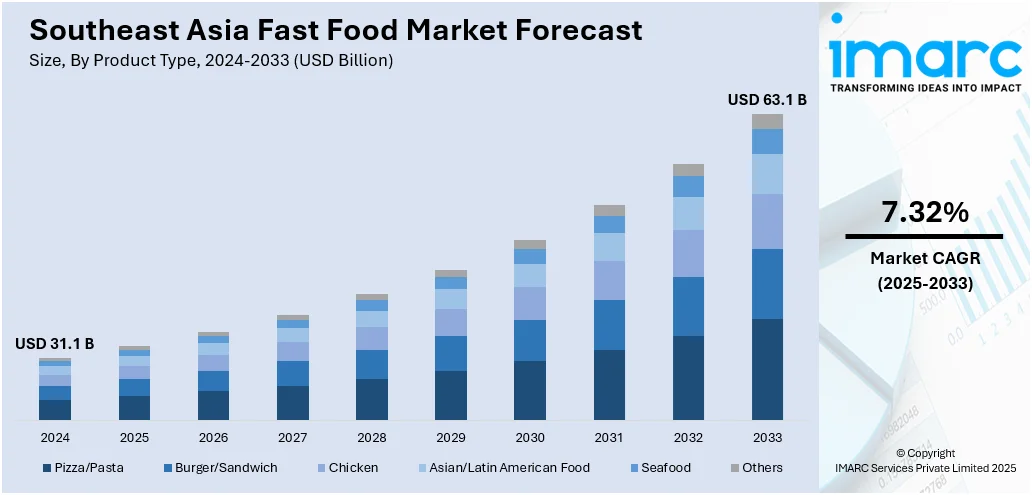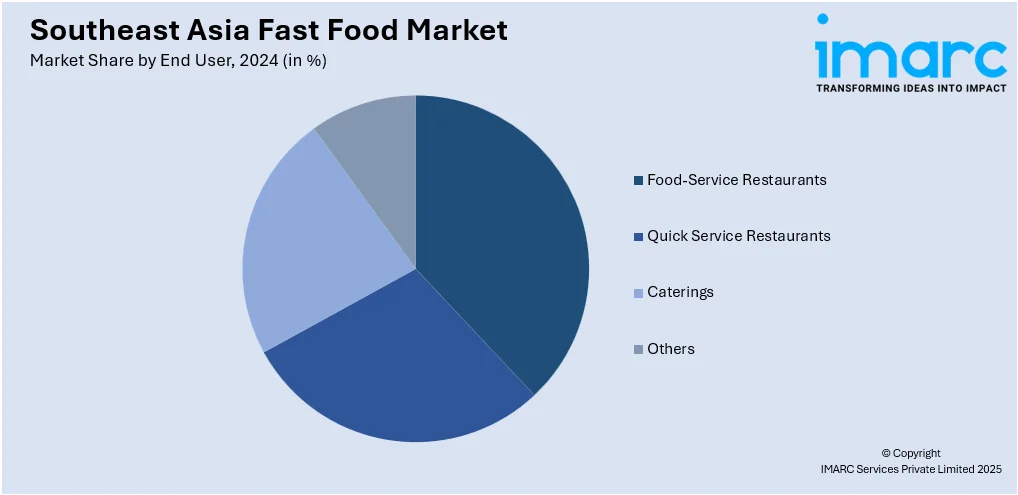
Southeast Asia Fast Food Market Report by Product Type (Pizza/Pasta, Burger/Sandwich, Chicken, Asian/Latin American Food, Seafood, and Others), End User (Food-Service Restaurants, Quick-Service Restaurants, Caterings, and Others), and Country 2025-2033
Market Overview:
The Southeast Asia fast food market size reached USD 31.1 Billion in 2024. Looking forward, IMARC Group expects the market to reach USD 63.1 Billion by 2033, exhibiting a growth rate (CAGR) of 7.32% during 2025-2033. The rapid urbanization and rising disposable incomes of individuals, the emerging global fast-food establishments across the region, and the changing consumer preferences toward fast food options represent some of the key factors driving the market.
|
Report Attribute
|
Key Statistics
|
|---|---|
|
Base Year
|
2024
|
|
Forecast Years
|
2025-2033
|
|
Historical Years
|
2019-2024
|
|
Market Size in 2024
|
USD 31.1 Billion |
|
Market Forecast in 2033
|
USD 63.1 Billion |
| Market Growth Rate 2025-2033 | 7.32% |
Fast food is prepared quickly and served for immediate consumption. It typically consists of pre-cooked or pre-prepared ingredients that are assembled and cooked rapidly to meet the demand for quick and convenient meals. Fast food establishments are known for their efficiency and speed in serving customers, making them a popular choice for individuals on the go. It offers convenience, making it a popular choice for individuals with busy lifestyles. These establishments offer numerous menu items, ranging from burgers and fries to pizza, tacos, and fried chicken, that are often standardized, allowing for consistent quality and taste across several locations of the same fast food chain. Additionally, fast food has an emphasis on speed of service, allowing customers to order at a counter, through a drive-thru window, or even online for delivery. It also provides a quick and hassle-free dining experience, making it an attractive option for those seeking a meal on short notice. Nowadays, fast food has become an integral part of modern food culture, with numerous chains and franchises operating across the region.

To get more information on this market, Request Sample
Southeast Asia Fast Food Market Trends:
The market is primarily driven by rapid urbanization and the rising disposable income. In addition, more individuals are moving from rural areas to cities in search of better economic opportunities, and their lifestyles and dietary habits are undergoing transformation, contributing to market growth. Also, fast food establishments, with their quick and convenient dining options, are catering to the needs of urban dwellers who often have busy schedules, augmenting the market growth. Moreover, several global fast-food giants made significant investments in expanding their presence across Southeast Asia, including opening new outlets in urban and suburban areas, representing another major growth-inducing factor. These chains also invested in aggressive marketing campaigns to raise brand awareness and capture a larger market share. Along with this, many international fast-food chains are successfully adapting their menus to suit local tastes and preferences, which involves incorporating regional ingredients and flavors into their offerings. For instance, McDonald's in Southeast Asia may serve rice-based dishes alongside traditional burgers. Besides this, the rising disposable incomes among the population allowed individuals to spend and dine out or order fast food as a convenient and affordable dining option, which is noticeable among the emerging middle class due to changing consumer preferences, accelerating the market growth. Furthermore, the growing fast-food industry offers attractive franchising opportunities, and many local entrepreneurs are eager to invest in established brands, resulting in the rapid proliferation of fast food outlets in the region, as franchisees open new stores and expand the reach of these brands, creating a positive market outlook.
Southeast Asia Fast Food Market Segmentation:
IMARC Group provides an analysis of the key trends in each segment of the market, along with forecasts at the regional and country levels for 2025-2033. Our report has categorized the market based on product type and end user.
Product Type Insights:
- Pizza/Pasta
- Burger/Sandwich
- Chicken
- Asian/Latin American Food
- Seafood
- Others
The report has provided a detailed breakup and analysis of the market based on the product type. This includes pizza/pasta, burger/sandwich, chicken, Asian/Latin American food, seafood, and others.
End User Insights:

- Food-Service Restaurants
- Quick Service Restaurants
- Caterings
- Others
A detailed breakup and analysis of the market based on the end user have also been provided in the report. This includes food-service restaurants, quick-service restaurants, caterings, and others.
Country Insights:
- Indonesia
- Thailand
- Singapore
- Philippines
- Vietnam
- Malaysia
- Others
The report has also provided a comprehensive analysis of all the major regional markets, which include Indonesia, Thailand, Singapore, Philippines, Vietnam, Malaysia, and Others.
Competitive Landscape:
The market research report has also provided a comprehensive analysis of the competitive landscape. Competitive analysis such as market structure, key player positioning, top winning strategies, competitive dashboard, and company evaluation quadrant has been covered in the report. Also, detailed profiles of all major companies have been provided.
Southeast Asia Fast Food Market Report Coverage:
| Report Features | Details |
|---|---|
| Base Year of the Analysis | 2024 |
| Historical Period | 2019-2024 |
| Forecast Period | 2025-2033 |
| Units | Billion USD |
| Scope of the Report | Exploration of Historical Trends and Market Outlook, Industry Catalysts and Challenges, Segment-Wise Historical and Future Market Assessment:
|
| Product Types Covered | Pizza/Pasta, Burger/Sandwich, Chicken, Asian/Latin American Food, Seafood, Others |
| End Users Covered | Food-Service Restaurants, Quick-Service Restaurants, Caterings, Others |
| Countries Covered | Indonesia, Thailand, Singapore, Philippines, Vietnam, Malaysia, Others |
| Customization Scope | 10% Free Customization |
| Post-Sale Analyst Support | 10-12 Weeks |
| Delivery Format | PDF and Excel through Email (We can also provide the editable version of the report in PPT/Word format on special request) |
Key Questions Answered in This Report:
- How has the Southeast Asia fast food market performed so far and how will it perform in the coming years?
- What is the breakup of the Southeast Asia fast food market on the basis of product type?
- What is the breakup of the Southeast Asia fast food market on the basis of end user?
- What are the various stages in the value chain of the Southeast Asia fast food market?
- What are the key driving factors and challenges in the Southeast Asia fast food?
- What is the structure of the Southeast Asia fast food market and who are the key players?
- What is the degree of competition in the Southeast Asia fast food market?
Key Benefits for Stakeholders:
- IMARC’s industry report offers a comprehensive quantitative analysis of various market segments, historical and current market trends, market forecasts, and dynamics of the Southeast Asia fast food market from 2019-2033.
- The research report provides the latest information on the market drivers, challenges, and opportunities in the Southeast Asia fast food market.
- Porter's five forces analysis assist stakeholders in assessing the impact of new entrants, competitive rivalry, supplier power, buyer power, and the threat of substitution. It helps stakeholders to analyze the level of competition within the Southeast Asia fast food industry and its attractiveness.
- Competitive landscape allows stakeholders to understand their competitive environment and provides an insight into the current positions of key players in the market.
Need more help?
- Speak to our experienced analysts for insights on the current market scenarios.
- Include additional segments and countries to customize the report as per your requirement.
- Gain an unparalleled competitive advantage in your domain by understanding how to utilize the report and positively impacting your operations and revenue.
- For further assistance, please connect with our analysts.
 Request Customization
Request Customization
 Speak to an Analyst
Speak to an Analyst
 Request Brochure
Request Brochure
 Inquire Before Buying
Inquire Before Buying




.webp)




.webp)












